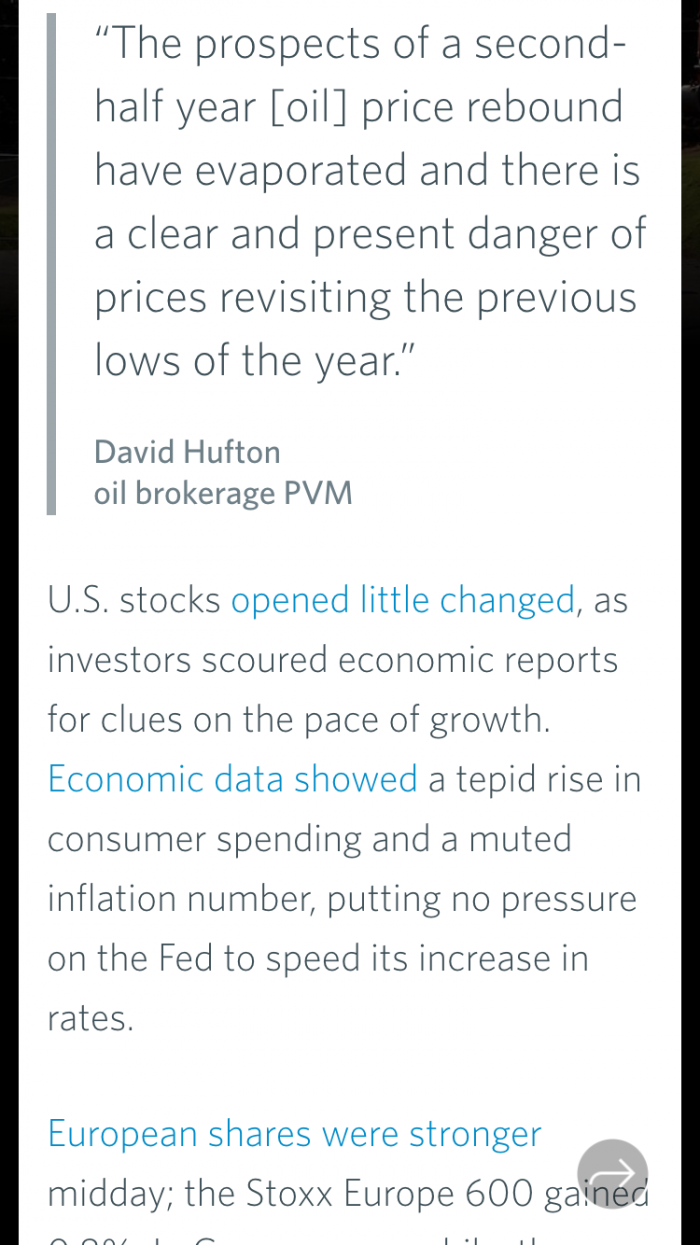
The What’s News app, named after the front-page column of news briefs well known to regular Journal readers, will launch later this summer to subscribers and will feature a curated digest of 10 stories, refreshed regularly throughout the workday by a small team of editors dedicated to writing and updating briefs. The concept for the new app emerged out of a concerted effort by the news desk to “think digital” and, more specifically, to “think mobile.”
 “We were simply doing what all journalists are now doing, which is thinking about digital journalism, what our readers want, and how you experience news on your phone,” said the Journal’s deputy editor-in-chief Matt Murray. “Somewhere we made the connection to the news digest already in our papers, What’s News.”
“We were simply doing what all journalists are now doing, which is thinking about digital journalism, what our readers want, and how you experience news on your phone,” said the Journal’s deputy editor-in-chief Matt Murray. “Somewhere we made the connection to the news digest already in our papers, What’s News.”
The What’s News column started appearing in the print version of The Wall Street Journal in 1934, an innovation of the 25-year-old Barney Kilgore (who would later serve as managing editor and who is credited with turning the paper around from near bankruptcy in the 1930s to a thriving business by the 1960s). More than 80 years later, the column still appears in print — and on the web — in a similar format.
 “We realized that in our heritage, we actually had a great concept already. Our readers love [What’s News] — it’s remained the most popular element of the print page,” Murray said. “If you want to scan the news quickly and want to be able to know what’s going on quickly, a phone isn’t always friendly for long stories. We were thinking about what readers might want when they’re not sitting down reading the paper.”
“We realized that in our heritage, we actually had a great concept already. Our readers love [What’s News] — it’s remained the most popular element of the print page,” Murray said. “If you want to scan the news quickly and want to be able to know what’s going on quickly, a phone isn’t always friendly for long stories. We were thinking about what readers might want when they’re not sitting down reading the paper.”
Around 44 percent of the Journal’s web traffic comes from mobile now, according to Roussel. He also cited recent studies that have found people check their smartphones upwards of 200 times a day.
The app is being beta-tested internally ahead of its release on iOS and has already run through focus groups. The main WSJ app will continue to live in the Apple and Android stores, but What’s News is a “fundamentally different experience,” according to Murray and Roussel. They emphasize that the app is less news wire than an “editorially driven group of stories where the story at the top is what [editors] think is the most important business story right now.”
The app consists of what Roussel called “three layers of experience.” When they open What’s News, users will see 10 — and only 10 — core headlines at any given moment; those will rotate and be updated regularly between 6 a.m. and midnight on weekdays (currently, centered around New York time, though in the future this app might adjust to country-specific content).
 Tapping a headline will open up a slightly longer story within the app. These briefs will be capped at around 350 words, will be optimized for mobile with liberal use of charts and graphs, and are intended as concise summaries of events with minimal analysis; readers can also tap links inside the story that will take them to other full-length Journal pieces, all within the app. Several advertisers are already signed up ahead of the launch, including Cartier.
Tapping a headline will open up a slightly longer story within the app. These briefs will be capped at around 350 words, will be optimized for mobile with liberal use of charts and graphs, and are intended as concise summaries of events with minimal analysis; readers can also tap links inside the story that will take them to other full-length Journal pieces, all within the app. Several advertisers are already signed up ahead of the launch, including Cartier.
As the Journal’s first mobile-only product, What’s News has integrated several features that are mobile-friendly, according to Murray. The app will include a morning brief, as well as recaps of stories readers may have missed overnight. When stock markets close, the app will push through an immediate update and send users an alert with highlights. On weekends, the editorial team might write pieces for it that look ahead to next week. Roussel and Murray say they’re also hoping to build a hub for key markets data, information that’s currently not easily accessible on phones.
“This is the first WSJ product truly for mobile,” Roussel said. “Twenty years ago, we were shoehorning the newspaper into web. In 2007, we began shoehorning that into a mobile device. And now mobile is becoming dominant — that’s the premise.”
What’s News is also one of the Journal’s several attempts over the past year to build out additional features for its close to 2.3 million subscribers — more than 724,000 of whom are digital subscribers — and to attract new ones. Last September, for instance, the Journal introduced a WSJ+ membership program, offering members access to newsroom tours, special talks, and opportunities to enter raffles geared towards the Journal set (“Golf Concierge,” anyone?).
But why have two co-existing apps, both for subscribers?
“If you’re a successful digital company, you always need to be open to coming up with better reader experiences,” Roussel said. “This [app] is about giving people valuable news, giving people their time back in a very condensed, finite way. The existing app runs the whole gamut, showing readers business news, top news, the CIO Journal, the CFO Journal.”
Plenty of news organizations are launching or thinking about launching their own digest apps now, so the new Journal app is entering a very crowded field of apps offering similar-sounding experiences. NYT Now, which became free in May after failing to reach its targeted number of paid signups, features its own Morning Briefing and selected package of stories, though aiming to skew younger. Last fall, The Economist launched its own digest app, Espresso, also aiming to serve up a “finite, finishable, very tightly curated bundle of content.” And earlier that year, Yahoo launched its Yahoo News Digest, which uses an algorithm as well as editors to surface around 10 stories in the morning and 10 at night, in an attempt to mimic newspaper consumption habits of old.What’s News will stand out, Roussel and Murray say, by focusing on what the Journal does best — business and finance. “We’re playing to our strengths here, and this gives us a clearly defined niche in a busy market,” Roussel said. “Our differentiators are our coverage of business markets, of economics. Our brand equity is tremendous.”
“In thinking about the app, we were trying to figure out the heritage of What’s News and what the digital age requires of us,” Murray said. “This is the app that Barney Kilgore would’ve built.”